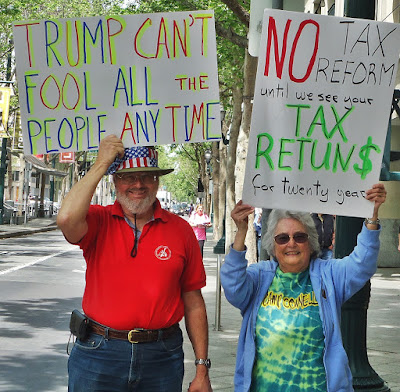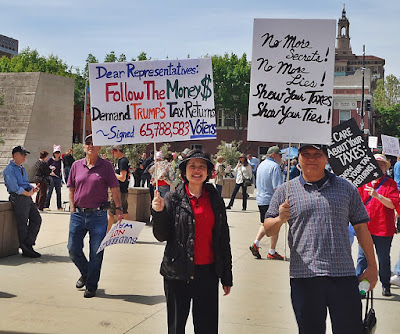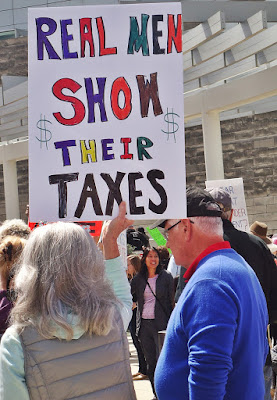Nobel Laureate Dr. William Moerner addressing the huge gathering
at the March for Science rally in Downtown San Jose on April 22.
at the March for Science rally in Downtown San Jose on April 22.
Moerner was one of several speakers at the “March for Science” rally in downtown San Jose at the Plaza de Cesar Chavez on Earth Day, April 22. “Today we carry supercomputers in our pockets,” he said. “We are harvesting energy from the sun without damaging nature.” Addressing climate-change deniers, he said, “Science is true whether or not you believe it,” drawing vigorous applause from his listeners who had come together to protest the policies of the ‘Denier-in-Chief’ in the White House. As to what each of us can do, the Nobel-laureate suggested that we learn how to detect fake science, how to explain the value of science to others, and to kindle our curiosity by figuring out how things work. “It’s even fun!” said Moerner, someone who should know.
About 10,000 of us – scientists, artists, students, teachers, mothers, fathers, daughters, sons and concerned citizens of every stripe and persuasion – had gathered in San Jose to affirm our faith in the importance of science in shaping our lives and in keeping our planet healthy. Similar rallies had taken place in all 50 states and in more than 500 cities around the world in seven continents.
I looked around. The posters, many made of recycled papers as befitting an Earth Day celebration, were pithy, thought-provoking, forceful, factual and witty in a nerdy way.
“The oceans are rising and so are we.”
“Evidence-based policy, not policy-based evidence, a.k.a. alternative facts.”
“No Science, Art or Humanities. No Freedom.”
“Super callow. Fragile ego. Trump you are atrocious."
“Without science you wouldn’t be taking that picture.”
“The ‘upside’ of climate change: Mara-a-Lago under water.”
“Atoms make up everything. So does he.”
The combination of outrage and passion – outrage at Trump’s destructive policies and passion for the health of the earth (“There is no planet B”) – was ineffably inspiring.
Jennifer had a ‘scientific’ message for people: “Think like a proton. Be positive.” Francesca had bedecked herself as Miss Liberty: “May we always have the liberty to seek the Truth.” Arthur used a metaphor from chemistry: “If you’re not a part of the solution, you‘re part of the precipitation.” Third-grader Eli, standing next to his approving father, was clear about his career: “I want to be
There were more women than men, debunking the myth that girls are not into science. 5-year-old Sophia, perched on her mother’s shoulder, declared: “I love science.” A woman weaved her way through the crowd: “Back off, man! I’m a scientist!” Another woman warned of the danger of learning science from politicians and not from scientists like her. Dvina, a native of San Jose currently working as a medical researcher at the University of Munich in Germany, was using her vacation time to reinforce the theme of the rally: “Science not Silence.” The proud parents of 3-month-old Lucia had pinned this sign to her stroller: “Forget princess! I want to be a rocket scientist.”
Dr. Jose Cabrera, a chemistry professor at San Jose City College elicited roars of approval when he identified the critical role community colleges play in America’s educational system and his impassioned plea to young people to consider STEM (Science, Technology, Engineering, Math) fields as careers. (Disclaimer: Dr. Cabrera was my mentor at City College during my tenure process as a math faculty.) “We are seeing the spread of pseudo-science in our country,” he said. “We must distinguish between science and pseudo-science and learn to see the extraordinary in the seemingly ordinary.”
The math-themed signs were especially fascinating. Charles, a biophysics PhD from UCSF wanted everyone to know why the irrational number Pi matters: “3.14159 makes everything just so fine!” Crystal’s message was simple with profound implications: “I love Math.” But the most incisive message came from Dora and her 6th-grader son, Adrian who had designed posters praising the contributions of 8th-century mathematician al-Khwarizmi, considered the father of algebra. Married to an American, Dora is a Bulgarian who was praising a Muslim mathematician from olden times! Only in immigrant-rich America was this possible.
Tracy Van Houten, a rocket scientist at NASA’s Jet Propulsion Laboratory (JPL), also extolled the value of STEM, particularly for girls and minorities. “Scientists are underrepresented in our government,” she said. Of the 535 members of the Two Houses of Congress, only 11 are scientists. “That’s less than 2 percent! We have to not only protect science but also scientists,” she said. “We will prevail because Trump fears facts and facts are on our side.” Houten had to recently make a wrenching decision. “I was exploring the universe but gravity pulled me back to earth. I loved my job at the JPL,” she said, “but I felt the fierce urgency of now, this calling to rescue our country from partisan muck and science-deniers and put science back at the center of decision-making.” After Trump’s election, she quit her JPL job and is now running to represent the 34th Congressional District of California in the Congress.
The rally was billed not as a protest but as a march to affirm the value of science and to demand that the Trump administration use facts rather than polarizing and paralyzing ideologies to frame policies. We have a president who ignores evidence in favor of opinion, who has picked, as administrator of the Environmental Protection Agency (EPA), a man who denies that carbon dioxide is a primary source of global warming. Trump’s proposed budget would cut $12.6 billion from the Department of Health and Human Services, including $5.8 billion from the National Institute of Health alone, with potentially disastrous consequences for medical research. His ban on immigration threatens our scientific institutions like MIT, a significant percentage of whose faculty is foreign-born.
What will it mean for America if Trump has his way? Byron, a marine biologist, shared his perspective with me at the rally. “I don’t believe Trump will succeed. He will probably be neutered by division within his own party. His policies are likely to grind to a halt. But we can never be sure, so we have to keep up the momentum.”
The most moving moment at the rally came when I ran into 14-year-old Justin, a sophomore at the local Bellarmine College Preparatory. Justin suffers from Wilson’s disease, a rare inherited disorder caused by the mutation of a certain type of gene that leads to liver inflammation and reduced kidney function. “If it were not for drugs like syprine developed by scientists at Wilson’s Disease Association, I wouldn’t be here. I owe my life to medical science.”









































































